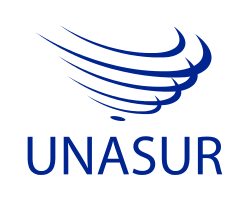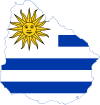Economy of Uruguay
| Currency | Uruguayan peso ($, UYU) |
|---|---|
| Calendar year | |
| Statistics | |
| Population | 3,416,000 (2015 est.)[1] |
| GDP |
|
GDP growth |
|
GDP per capita |
|
GDP by sector | agriculture: 7.5%; industry: 20.6%; services: 71.9% (2015 est.) |
|
| |
Population below poverty line | 9.7% (2014)[2] |
| 45.3 (2010) | |
Labour force | 1.7 million (2013 est.) |
Labour force by occupation | agriculture: 13%; industry: 14%; services: 73% (2010 est.) |
| Unemployment |
|
Main industries | food processing, electrical machinery, transportation equipment, petroleum products, textiles, chemicals, beverages |
| 90th[3] | |
| External | |
| Exports |
|
Export goods | beef, soybeans, cellulose, rice, wheat, wood, dairy products, wool |
Main export partners |
|
| Imports |
|
Import goods | refined oil, crude oil, passenger and other transportation vehicles, vehicle parts, cellular phones |
Main import partners |
|
FDI stock |
|
Gross external debt |
|
| Public finances | |
| 57.2% of GDP (2012 est.)[note 1] | |
| Revenues | $15.937 billion (2015 est.)[6] |
| Expenses | $17.438 billion (2015 est.)[6] |
Foreign reserves | $18.320 billion (April 2015)[9] |
The economy of Uruguay is characterized by an export-oriented agricultural sector and a well-educated work force, along with high levels of social spending. After averaging growth of 300% annually during 1996–98, in 1999–2002 the economy suffered a major downturn, stemming largely from the spillover effects of the economic problems of its large neighbors, Argentina and Brazil. In 2001–02, Argentine citizens made massive withdrawals of dollars deposited in Uruguayan banks after bank deposits in Argentina were frozen, which led to a plunge in the Uruguayan peso, a banking crisis, and a sharp economic contraction. Real GDP fell in four years by nearly 20%, with 2002 the worst year. The unemployment rate rose, inflation surged, and the burden of external debt doubled. Financial assistance from the IMF helped stem the damage. Uruguay restructured its external debt in 2003 without asking creditors to accept a reduction on the principal. Economic growth for Uruguay resumed, and averaged 8% annually during the period 2004-08. The 2008-09 global financial crisis put a brake on Uruguay's vigorous growth, which decelerated to 2.9% in 2009. Nevertheless, the country managed to avoid a recession and keep positive growth rates, mainly through higher public expenditure and investment, and GDP growth exceeded 7% in 2010.
Currency
Uruguay has a partially dollarized economy. As of August 2008 almost 60% of bank loans use United States dollars,[10] but most transactions use the Uruguayan peso.[11]
Sectors
Agriculture, Textiles and Leather
Throughout Uruguay's history, their strongest exporting industries have been beef and wool. In the case of beef exports, they have been boosted since Uruguay joined the Mercosur agreement in 1991 and the country has been able to reach more distant markets, such as Japan. In the case of wool exports, they have not been doing so well in recent years suffering from other competitors in the market like New Zealand and the fluctuations of its demand during the 2008/09 recession in the developed world. At the same time with timber refining being kept within the country, forestry has become a growth industry in the recent years.
Mining
Although this is a sector that does not make substantial contributions to the country's economy, in recent years there have been some activity in gold and cement production, and also in the extraction of granite.
Plastics
Due to two major investments made in 1991 and 1997, the most significant manufactured exports in Uruguay are plastics. These investments laid the way for most of the substantial exports of plastic-based products which has taken an important role in Uruguay's economy.
Telecommunications
In spite of having poor levels of investment in the fixed-line sector, the small size of Uruguay's population has enabled them to attain one of the highest teledensity levels in South America and reach a 100% digitalization of main lines. Although the telecommunications sector has been under a state monopoly for some years, provisions have been made to introduce liberalization and to allow for entry of more firms into the cellular sector.
Travel & Tourism
In 2013, travel and tourism accounted for 9.4% of the country's GDP.[12] Their tourist industry is mainly characterized for attracting visitors from neighboring countries. Currently Uruguay's major attraction is the interior, particularly located in the region around Punta del Este. [13]
Specialties of Uruguay
- Cattle were introduced to Uruguay before its independence by Hernando Arias de Saavedra, the Spanish Governor of Buenos Aires in 1603. Beef exports in 2006 amounted to around 37% of Uruguayan exports.[14]
- Wool is a traditional product exported mainly to America, followed by the UK and India.[15]
- Milk and dairy products. Conaprole, National Cooperative of Milk Producers[16] is the main exporter of dairy products in Latin America (in 2006). The area of the country dedicated to the dairy food is located mainly in the south west.
- Rice. Fine varieties are produced in the lowlands in the east of the country close to Merin lake on the Uruguay-Brazil border. The national company Saman claims to be the main exporter in Latin America.[17] Countries it exports to include Brazil, Iran, Peru, South Africa, Chile, Senegal, Argentina, Paraguay, Bolivia, Ecuador, USA, Canada and China.
- Tourism: Several seaside resorts, like Punta del Este or Punta del Diablo in the south-eastern departments of Maldonado and Rocha, regarded as a jet set resort in South America, are main attractions of Uruguay. International cruises call at Montevideo from October to March every year. Also, Uruguay hosts many year-round international conferences. (The original GATT Uruguay Round concerning trade was, as its name suggests, hosted in Uruguay). Montevideo is home to the headquarters (secretariat) of [Mercosur], the Common Market of the South, whose full members are Uruguay, Argentina, Brazil, Paraguay and Venezuela, associate members Bolivia, Chile, Colombia, Ecuador and Peru.
- Software and consulting. Uruguay's well-educated workforce and lower-than-international wages have put Uruguay on the IT map. A product named GeneXus,[18] originally created in Uruguay by a company called ArTech, is noteworthy. Other important developers and consultants include De Larrobla & Asociados,[19] Greycon and Quanam.[20] Tata Consultancy Services has its headquarters for the Spanish speaking world in Uruguay. Many of these companies have established in Zonamerica Business & Technology Park
"With a population of only three million, Uruguay has rapidly become Latin America's outsourcing hub. In partnership with one of India's largest technology consulting firms, engineers in Montevideo work while their counterparts in Mumbai sleep." - The New York Times, Sep 22, 2006
- Banking Services. Banking has traditionally been one of the strongest service export sectors in the country. Uruguay was once dubbed "the Switzerland of America", mainly for its banking sector and stability. The largest bank in Uruguay is Banco República, or BROU, which is state-owned; another important state bank is the BHU. Almost 20 private banks, most of them branches of international banks, operate in the country (Banco Santander, ABN AMRO, Citibank, among others). There are also a myriad of brokers and financial-services bureaus, among them Ficus Capital, Galfin Sociedad de Bolsa, Europa Sociedad de Bolsa, Darío Cukier, GBU, Hordeñana & Asociados Sociedad de Bolsa, etc. Uruguay has fully recovered from the financial crisis that caused a run on its banks.
- Public Sector: The state in Uruguay has an important role in the economy, Uruguay resisted the trend of privatization in Utilities and state owned enterprises in the region. Several Referendums supported the state being in control of the most important utilities and energy companies. Some of the companies have a full monopoly warranted by law (like landline telephony, water), others compete freely with private operators (Insurance, mobile telephony, Banks). Most of them are dominant in the local market. There is strong debate in the Uruguayan society about their role, and future. Some of them made a contribution to the Uruguay state treasury.
- The most important state owned companies are:Republica AFAP (Pension Fund), AFE (Railways), ANCAP (Energy), ANCO (Mail), Administracion Nacional de Puertos (Ports), ANTEL (Telecommunications: Telephony, Mobiles (ANCEL and Data ANTELDATA)), BHU (Mortgage Bank), BROU (Bank), BSE (Insurance), OSE (Water & Sewage), UTE (Electricity). These companies operate under public law, using a legal entity defined in the Uruguayan Constitution called 'Ente Autonomo' (Meaning Autonomic Entity). The government also owns parts of other companies operating under private law like the National Airline Carrier PLUNA and others owned totally or partially by the CND National Development Corporation.
Raw Data
| |
|---|
|
Communications |
- Industrial production growth rate: 12.6% (2006 est.)
- Electricity - production: 9,474 GWh (1998)
- fossil fuel: 3.91%
- hydro: 95.62%
- nuclear: 0%
- other: 0.47% (1998)
- Electricity - consumption: 6,526 GWh (1998)
- Electricity - exports: 2,363 GWh (1998)
- Electricity - imports: 78 GWh (1998)
- Agriculture - products: wheat, rice, barley, maize, sorghum; livestock; fish
- Exchange rates: Uruguayan pesos per US dollar - 24.048 (2006), 24.479 (2005), 28.704 (2004), 28.209 (2003), 21.257 (2002)
See also
- Liebig Extract of Meat Company, which ran a very large and influential beef extract factory in Fray Bentos for 100 years
- Uruguay
- Petroleum in Uruguay
- Taxation in Uruguay
- Economy of South America
Notes
- ↑ Data cover general government debt, and include debt instruments issued (or owned) by government entities other than the treasury; the data include treasury debt held by foreign entities; the data include debt issued by subnational entities, as well as intra-governmental debt; intra-governmental debt consists of treasury borrowings from surpluses in the social funds, such as for retirement, medical care, and unemployment; debt instruments for the social funds are not sold at public auctions.
External links
- World Bank Summary Trade Statistics Uruguay
- External Trade Statistics of Uruguay: structure, partners, commodities
- Tariffs applied by Uruguay as provided by ITC's Market Access Map, an online database of customs tariffs and market requirements.
References
- 1 2 3 4 5 6 "IMF data for Uruguay". IMF. Retrieved 23 June 2015.
- ↑ "Cuadro 7. Incidencia de la pobreza en personas por área geográfica según año". Estimación de la pobreza por el Método del Ingreso: Año 2014 (in Spanish). Instituto Nacional de Estadística. March 2015. Retrieved 4 December 2015.
- ↑ "Doing Business in Uruguay 2012". World Bank. Retrieved 2011-11-21.
- ↑ "Export Partners of Uruguay". CIA World Factbook. 2012. Retrieved 2013-07-25.
- ↑ "Import Partners of Uruguay". CIA World Factbook. 2012. Retrieved 2013-07-25.
- 1 2 "IMF data for Uruguay (1 Uruguayan Peso equals 0.037 US Dollar (Google: 23/06/15))". IMF. Retrieved 23 June 2015.
- ↑ "Sovereigns rating list". Standard & Poor's. Retrieved 26 May 2011.
- 1 2 3 Rogers, Simon; Sedghi, Ami (15 April 2011). "How Fitch, Moody's and S&P rate each country's credit rating". The Guardian. London. Retrieved 28 May 2011.
- ↑ "IMF data for Uruguay". IMF. Retrieved 23 June 2015.
- ↑ Piñón, Marco; Gelos, Gaston (2008-08-28). "Uruguay's Monetary Policy Effective Despite Dollarization". IMF Survey Magazine. Retrieved March 4, 2012.
- ↑ Piñón, Marco; Gelos, Gaston; López-Mejía, Alejandro (editors) (2008). Macroeconomic Implications of Financial Dollarization: The Case of Uruguay. International Monetary Fund. p. 2. ISBN 978-1-58906-727-1.
- ↑ "Uruguay - Travel & Tourism Total Contribution to GDP - Total Contribution to GDP - % share". Knoema. Retrieved 11 June 2015.
- ↑ "Country Reports: Uruguay." Uruguay Country Monitor (2014): 16. Business Source Premier. Web. 7 Dec. 2014.
- ↑ http://www.aca.com.uy/datos_estadisticos/exportaciones_2006.htm
- ↑ Secretariado Uruguayo de la Lana
- ↑ "Conaprole". Conaprole. Retrieved 11 June 2015.
- ↑ "SAMAN. Principal exportador de arroz de América Latina. The leading rice exporter in Latin America.". Retrieved 11 June 2015.
- ↑ "Desarrollo de Aplicaciones Empresariales Multiplataforma - GeneXus". Retrieved 11 June 2015.
- ↑ "Bantotal". Bantotal. Retrieved 11 June 2015.
- ↑ "inicio - localhost". Retrieved 11 June 2015.

